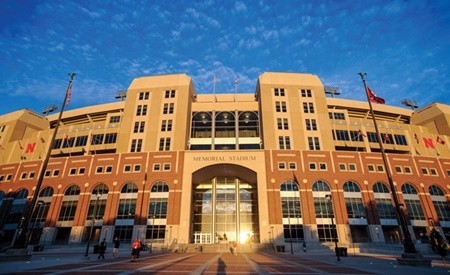Nebraska’s Memorial Stadium is 94 years old, yet it stands as one of the most progressive football venues in the country.
Stanford Stadium, originally constructed in 1921, is even older by three years and it too is considered advanced, by most measures in college football.
What those stadiums have that most others don’t is a Wi-Fi signal that runs through the concourses and into the bowl, and in some cases out to the parking lot.
 |
Nebraska has one of the few college stadiums with a Wi-Fi signal available throughout.
Photo by: GETTY IMAGES
|
Wi-Fi is available on most every college campus, but the networks typically aren’t found inside college stadiums. While Wi-Fi represents an obvious fan enhancement at stadiums, it’s also expensive, running up to $5 million for design and installation, and sometimes more for older facilities.
Nebraska and Stanford are among roughly eight schools nationally that have Wi-Fi throughout their stadiums. What makes it more remarkable is that they added Wi-Fi in stadiums that are nearly a century old.
“Older facilities like this one aren’t designed for Wi-Fi, so it costs you more,” said Dan Floyd, director of IT in Nebraska’s athletic department. “You find yourself drilling through a lot of really thick concrete. But our administration decided that Wi-Fi was something we had to have for our fans. We just saw it as an investment and a way to keep fans in their seats, which is becoming more and more of a challenge.”
Because cost is the single greatest impediment to getting Wi-Fi in football stadiums, it often falls on the athletic department to cover the expense. That can be a challenge, especially at public institutions that might require approval from university administration unless donors cover the cost.
“People expect to have Wi-Fi available,” Floyd said. “It’s just an expectation, whether you’re in a coffee shop or an NFL venue. But the NFL team is not competing with campus for funding.”
For schools that are contemplating Wi-Fi in their venues, the benefits of enhancing the fan experience are challenged by the cost.
For half of the schools that have Wi-Fi — Baylor, Mississippi, TCU and Texas A&M — they were able to install it as part of a major stadium renovation or new construction.
The rest, like Auburn, Nebraska, Penn State and Stanford, among others, had to go the more difficult route of installing Wi-Fi in older stadiums that weren’t built for the technology.
Florida is one of those schools considering Wi-Fi. The school had it installed as part of a $65 million renovation to Exactech Arena, its basketball venue, but the Gators still don’t have Wi-Fi throughout Ben Hill Griffin Stadium.
The decision with basketball was easy. The arena is used for several campuswide events, such as trade shows, graduation, concerts and other student programming. In fact, the athletic department didn’t even have to lobby for it. The university administration decided early in the renovation that Wi-Fi would be part of the project, though the cost of the installation was not available.
The school isn’t prepared just yet to make that commitment to football, largely because of the cost.
“Wi-Fi is a big topic of discussion across the SEC, especially football,” said Mike Hill, Florida’s executive associate athletic director for external affairs. “It’s an amenity that our customers are accustomed to now, wherever they go.”
The ability to improve the fan experience is one aspect of that, but there are other, perhaps more important benefits to adding Wi-Fi, including the collection of fan data.
“There’s as much or more of a business benefit to Wi-Fi than there is to the convenience for fans. Data is a big part of that,” Hill said. “We still have very few football venues with Wi-Fi, but data capture is as much or more of a motivation than anything.”
At Stanford, Deputy AD Ray Purpur, a 20-plus-year veteran at the school, oversees facilities and capital planning. When Stanford decided to install Wi-Fi five years ago — no records are kept on such things, but the Cardinal is thought to be the first college to have stadiumwide Wi-Fi — it was thought to be the start of a trend.
But it hasn’t caught on, at least not yet.
“Wi-Fi is the next frontier, but I think we’re still a couple of years away from this becoming a real trend in the college space,” said Norman Rice at Extreme Networks, a firm that works with sports and non-sports entities to design and install Wi-Fi. “What’s funny is that universities are usually the earliest adopters of technology and just about every college campus has Wi-Fi, except in their football stadium.”
Schools saw that AT&T and Verizon would upgrade the distributed antenna systems inside their stadiums, most of the time at no cost to the athletic department. A strong DAS, which improves the cell signal, is good enough for some schools, especially when the football stadium is in use only seven days a year, in many cases.
“It was intimidating for us because there wasn’t another college football stadium with Wi-Fi,” Purpur said.
With the help of AT&T and an installer, Stanford placed more than 600 Wi-Fi access points around the stadium. The cost of the project was not available.
Nebraska, whose stadium holds 85,000 versus Stanford’s 50,000, needed close to 900 access points to deliver the Wi-Fi signal, which cost a little more than $5 million to install.
And with the older stadiums, schools don’t have natural areas to install the access points, so they have to be hidden. The older facilities also don’t have weatherproof network closets that store computer equipment, so new solutions must be invented.
“It was one of the most complicated, yet fun projects we’ve done,” Purpur said. “There just wasn’t any way for the old system to keep up. Now you walk around the stadium and what you notice is that a lot of people are looking down at their phone. That’s a good thing, I guess.”




